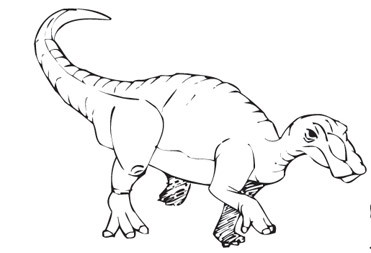Remembering Hadrosaurus foulkii the first major Dinosaur Find Researched in the USA
This year marks the 150th anniversary of the discovery and description of the first major dinosaur find in the United States (Hadrosaurus foulkii). In 1858, the distinguished anatomist Dr Joseph Leidy of the University of Pennsylvania examined a series of large fossil bones that had been unearthed at Haddonfield, New Jersey on the United States east coast.
A number of other fossil bones and teeth had come to light earlier, for example, Leidy himself was sent some fossil teeth found in Montana in 1855, but this was the first time a large deposit of fossil bones, seemingly belonging to one animal had been found.
Dr Leidy was aware of the discoveries of dinosaur remains in Europe and he named and described the bones as belonging to a new type of dinosaur “a great extinct herbivorous lizard” that “may have been in the habit of browsing, sustaining itself, kangaroo-like, in an erect position on its back extremities and tail”.
This dinosaur was named Hadrosaurus foulkii in honour of the amateur naturalist William Parker Foulke who had discovered the fossils.
This was the first dinosaur to be named and described in the United States, although other names for isolated fossil bones and teeth had been used by American scientists for some time – a classic being the now defunct Trachodon.
It was Leidy who first put forward the hypothesis that hadrosaurs like Hadrosaurus were amphibious – swimming animals that either lived in and around marshes or lakes, or fled into them if they had been threatened by a predator.
A number of events are planned to commemorate this momentous event, although the genus Hadrosaurus is debated in some circles and it can be regarded as not valid. Unfortunately, the specimen excavated in 1858 lacked a skull, and the lack of a skull (key diagnostic in classifying hadrosaurines), means that it cannot be classified with certainty. This explains why Hadrosaurus foulkii is often omitted from text books.
Hadrosaurus was typical of the hadrosaurines – the flat-headed duck-billed dinosaurs, if they possessed head crests they were very small, unlike their flamboyant relatives the lambeosaurines with their extravagant crests such as seen on dinosaurs like Parasaurolophus and lambeosaurus.
An Illustration of a Typical Hadrosaurine Duck-Billed Dinosaur like Hadrosaurus

Picture credit: Everything Dinosaur
The lack of a skull, did not stop the enterprising American scientific community putting this find on display. In 1868, this fossil was put on exhibit at the Philadelphia Academy of Natural Sciences. Helping in the construction of this exhibit was the English sculptor Benjamin Waterhouse Hawkins, who had been employed by Sir Richard Owen to create the Crystal Palace dinosaur models for the Great Exhibition in 1851.
To read more about the work of Benjamin Waterhouse Hawkins: The Central Park Mystery.
Hadrosaurus may remain a nomen dubium, but the skeleton remains on display to this day.
Everything Dinosaur stocks a wide range of prehistoric animal models including replicas of hadrosaurs and lambeosaurs. For example, the CollectA Age of Dinosaur Popular range contains many duck-billed dinosaur figures: CollectA Age of Dinosaurs Popular Range.






Leave A Comment